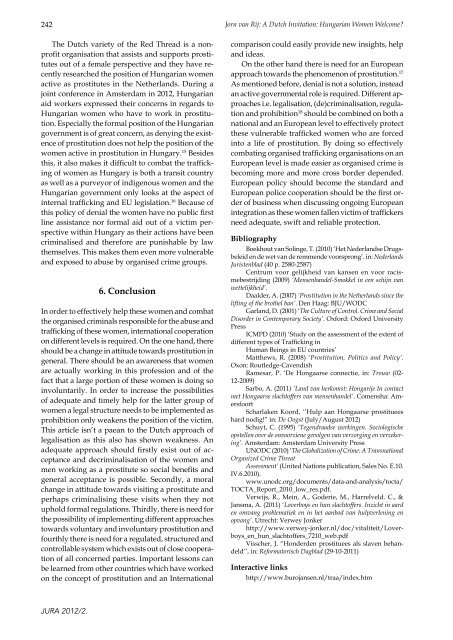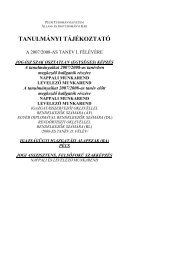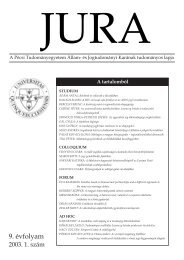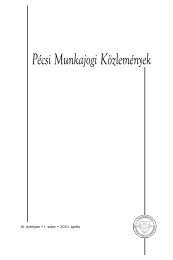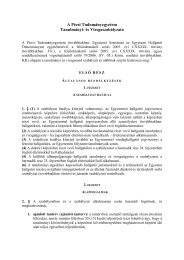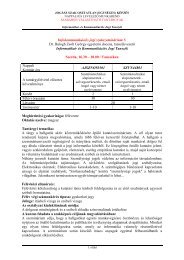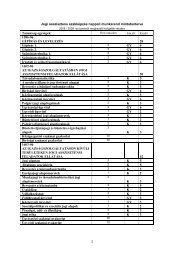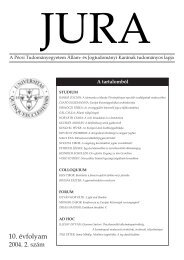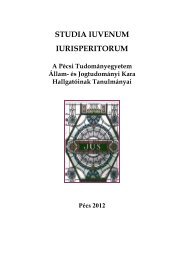2012. évi 2. szám - Jura - Pécsi Tudományegyetem
2012. évi 2. szám - Jura - Pécsi Tudományegyetem
2012. évi 2. szám - Jura - Pécsi Tudományegyetem
- TAGS
- jura
You also want an ePaper? Increase the reach of your titles
YUMPU automatically turns print PDFs into web optimized ePapers that Google loves.
242 Jorn van Rij: A Dutch Invitation: Hungarian Women Welcome?The Dutch variety of the Red Thread is a nonprofitorganisation that assists and supports prostitutesout of a female perspective and they have recentlyresearched the position of Hungarian womenactive as prostitutes in the Netherlands. During ajoint conference in Amsterdam in 2012, Hungarianaid workers expressed their concerns in regards toHungarian women who have to work in prostitution.Especially the formal position of the Hungariangovernment is of great concern, as denying the existenceof prostitution does not help the position of thewomen active in prostitution in Hungary. 15 Besidesthis, it also makes it difficult to combat the traffickingof women as Hungary is both a transit countryas well as a purveyor of indigenous women and theHungarian government only looks at the aspect ofinternal trafficking and EU legislation. 16 Because ofthis policy of denial the women have no public firstline assistance nor formal aid out of a victim perspectivewithin Hungary as their actions have beencriminalised and therefore are punishable by lawthemselves. This makes them even more vulnerableand exposed to abuse by organised crime groups.6. ConclusionIn order to effectively help these women and combatthe organised criminals responsible for the abuse andtrafficking of these women, international cooperationon different levels is required. On the one hand, thereshould be a change in attitude towards prostitution ingeneral. There should be an awareness that womenare actually working in this profession and of thefact that a large portion of these women is doing soinvoluntarily. In order to increase the possibilitiesof adequate and timely help for the latter group ofwomen a legal structure needs to be implemented asprohibition only weakens the position of the victim.This article isn’t a paean to the Dutch approach oflegalisation as this also has shown weakness. Anadequate approach should firstly exist out of acceptanceand decriminalisation of the women andmen working as a prostitute so social benefits andgeneral acceptance is possible. Secondly, a moralchange in attitude towards visiting a prostitute andperhaps criminalising these visits when they notuphold formal regulations. Thirdly, there is need forthe possibility of implementing different approachestowards voluntary and involuntary prostitution andfourthly there is need for a regulated, structured andcontrollable system which exists out of close cooperationof all concerned parties. Important lessons canbe learned from other countries which have workedon the concept of prostitution and an Internationalcomparison could easily provide new insights, helpand ideas.On the other hand there is need for an Europeanapproach towards the phenomenon of prostitution. 17As mentioned before, denial is not a solution, insteadan active governmental role is required. Different approachesi.e. legalisation, (de)criminalisation, regulationand prohibition 18 should be combined on both anational and an European level to effectively protectthese vulnerable trafficked women who are forcedinto a life of prostitution. By doing so effectivelycombating organised trafficking organisations on anEuropean level is made easier as organised crime isbecoming more and more cross border depended.European policy should become the standard andEuropean police cooperation should be the first orderof business when discussing ongoing Europeanintegration as these women fallen victim of traffickersneed adequate, swift and reliable protection.BibliographyBoekhout van Solinge, T. (2010) ‘Het Nederlandse Drugsbeleiden de wet van de remmende voorsprong’. in: NederlandsJuristenblad (40 p. 2580-2587)Centrum voor gelijkheid van kansen en voor racismebestrijding(2009) ‘Mensenhandel-Smokkel in een schijn vanwettelijkheid’.Daalder, A. (2007) ‘Prostitution in the Netherlands since thelifting of the brothel ban’. Den Haag: BJU/WODCGarland, D. (2001) ‘The Culture of Control. Crime and SocialDisorder in Contemporary Society’. Oxford: Oxford UniversityPressICMPD (2010) ‘Study on the assessment of the extent ofdifferent types of Trafficking inHuman Beings in EU countries’Matthews, R. (2008) ‘Prostitution, Politics and Policy’.Oxon: Routledge-CavendishRamesar, P. ‘De Hongaarse connectie, in: Trouw (02-12-2009)Sarbo, A. (2011) ‘Land van herkomst: Hongarije In contactmet Hongaarse slachtoffers van mensenhandel’. Comensha: AmersfoortScharlaken Koord, ‘’Hulp aan Hongaarse prostitueeshard nodig!” in: De Oogst (July/August 2012)Schuyt, C. (1995) ‘Tegendraadse werkingen. Sociologischeopstellen over de onvoorziene gevolgen van verzorging en verzekering’.Amsterdam: Amsterdam University PressUNODC (2010) ‘The Globalization of Crime: A TransnationalOrganized Crime ThreatAssessment’ (United Nations publication, Sales No. E.10.IV.6.2010).www.unodc.org/documents/data-and-analysis/tocta/TOCTA_Report_2010_low_res.pdf.Verwijs, R., Mein, A., Goderie, M., Harrelveld. C., &Jansma, A. (2011) ‘Loverboys en hun slachtoffers. Inzicht in aarden omvang problematiek en in het aanbod van hulpverlening enopvang’. Utrecht: Verwey Jonkerhttp://www.verwey-jonker.nl/doc/vitaliteit/Loverboys_en_hun_slachtoffers_7210_web.pdfVisscher, J. “Honderden prostituees als slaven behandeld’’,in: Reformatorisch Dagblad (29-10-2011)Interactive linkshttp://www.burojansen.nl/traa/index.htmJURA 2012/<strong>2.</strong>


